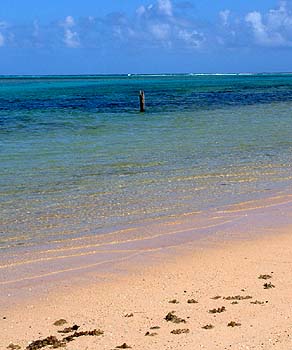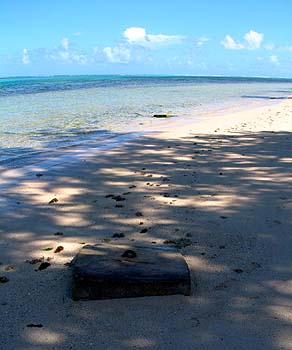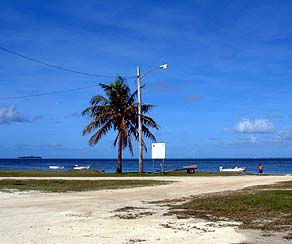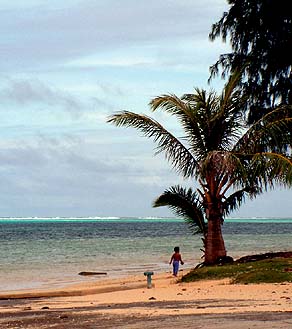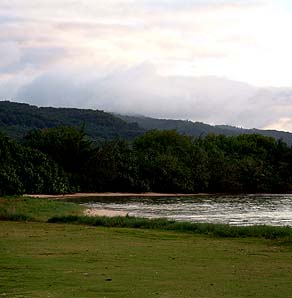 |
 |
 |
|||||
|
|
|
|
|
|
|
|
|
|
|
|||||||
|
|
|
|
|
|
"This is the main beach,” Ben says. “If someone says, ‘Go down to Tanapag Beach,’ this is the location they mean. It’s easily accessible. You can practically walk down there and park yourself, we have an infrastructure here, and a social hall over there. You can just say to anyone, ‘Meet me at Tanapag Beach,’ and they’ll be right here."
|
||
|
|
||
“Kids have grown up swimming on this beach here. Almost every Sunday, if you’d just come and sit down here on the beach, eventually, the water will be full of children swimming out there. To date, with all of the children and the people of the village who swim here, we have never seen any of our own people drown. "But some visitors have; maybe five people have died out in this water. And they’re not from the island. They’re from China, from Korea, from Japan, out here either snorkeling or scuba diving, and they have drowned and died. I think it’s very difficult to try to drown yourself, but five of them accomplished that mission.”
|
|
|
“We have other beach names that coincide with landowners. Like we have a Lifoifoi Beach, we have a Naog Beach, we have an Igitol beach. Actually we don’t call it Igitol Beach, we call it Don Pablo. That’s the first name of Don Pablo Igitol. These names haven’t changed.” “Down further is Benny Sablan,” says Rosa Tenorio, pointing down the beach. “And then this is owned by the Naog family, and then this property here is owned by the Tenorio family, which is my family. This next property belongs to another family, but during Typhoon Jean they had to evacuate everybody, and the government gave them what you call ‘land exchange.’ "And that one,” she points to one house still standing, “he absolutely refused to move, so that’s the only reason why he’s still there. I think, if I’m not mistaken, there’s only two private properties on the whole beach.”
|
|
|
|
|
|
“We used to call this beach ‘NTTU Beach’,” Ben says of the Tanapag waterfront. “That’s when the CIA was here, and they had that fenced off, and we’d watch them from the other side, all the things that were happening. That telephone pole in the water, still surviving today, that was the diving board for the military. And, immediately, maybe 20 feet further, is the pontoon, maybe about 20 x 20 foot pontoon raft. We can see the anchor for the pontoon, which was brought in by the typhoon. But right here on the launching ramp is the place for the sliding board. And we’d be watching, saying ‘What’s going on down there?’”
|
||
|
|
||
The beach was also the site of a few "cottage industries." Dave explains, “Long time ago on our farm, Danny and I, we’d go out together with the rest of the young people, and swim in the water. After swimming we had to be productive: whatever we could find that was necessary, important, we would turn it around as a good source of our living. Like the shells. We collected them and we make them into afok, the lime, for betel nut.”
|
|
|
“When my father would fill up a bull cart with dry tangan tangan wood, and one of my nephews would drive the bull cart to our house,” Estella recounts, “my mother would stay behind picking up more wood and carrying it on her shoulder. This is because she’s making salt from the ocean. Homemade salt. We never had to buy salt. She always dried salt for us. “She did this down at the beach. Since we lived close to the ocean, she’d just go out every time the water was low in the pot—it was a metal military pot—she would go down and refill it. She would get a coconut shell and she would tie it up to a stick, making a big ladle, and she would put that in the pot and collect all the filth off the top of the salt and throw it out. Day and night her fire would be going, day and night. And so the salt content was concentrated."
|
“There’s an incident that I'd like to relate,” Ben interjects. “All along the beach there were war relics. Also bombs and bullets that were never cleaned up by the military. And so one of her grandsons picked up some ordnance, bullets on the beach, and went and threw them in that fireplace and blew up the salt factory. It was later repaired and she continued to make salt. "That was a big incident. We thought nobody would have the mind to pick up bullets on the shore and throw them in the fire. Plus, we never thought that those bullets were still alive until we found out too late, and they blew up the factory for making salt. That’s an incident that we’ll never forget. Nobody got hurt. But I tell you, it scared the dogs away."
|
|
|
|
|
|
| "Once she dried the salt,” Estella continues, “she would go and get a wooden box and put the dried salt in there and cover it. Sometimes she could make three wooden boxes of salt. “The men went out for net fishing, and as they came in they divided fish among however many people went out. All those people got their division, their share. They would come to the house and give my mom the fish. And then, if my mom received fish, she would fill up one small coffee can with salt, and she’d come out and give it to them."
|
||
|
|
||
“That's because the salt is used to preserve the fish,” Ben explains. “In those days no icebox, no deep freeze. So you dry it with salt.” “We wouldn’t go fishing everyday,” Dave adds, “so when you got your share, you had to find a way to clean the fish good and apply salt and dry it up on the tin, and then you conserve that for a meal for one week or something like that.” “So it’s a barter system,” Ben says. “The advent of preservation has changed that. Before, we salted our fish or we smoked the fish. Today, what do we do?” “Freezer,” Pete replies.
|
|
|
“I was about ten or eleven years old when I started fishing," Pete says. "We didn’t have deep freeze, ice box. Not even ice during those times. So what my grandmother used to do, whenever I caught fish, she would just soak it, hang it on top of the kitchen stove with the smoke coming off. And they would not let the fire die. They would continuously put wood on it. This is the all wood stove. We smoked not only fish, but also pig and cow in this manner; there's no difference.” “That’s why we always cut wood,” Ben says, “so that we can cook our food. That has been a very big change in our life today. I have not cut firewood for the last 20 years. What you think, we’re spoiled or what?” “Yes, we’re spoiled,” Pete replies. “Nearly everything that comes in, comes in easy. Not like before.”
|
|
|
|
For this originally Carolinian community, the beach is also the launching platform for the wide range of activities that took place on the reef.
|
||
|
|
||
|
|
|
|
|
|

|
| Tanapag Home | Map Library | Site Map | Pacific Worlds Home |
|
|
|
|

|
|
|
|||
| Copyright 2003 Pacific Worlds & Associates • Usage Policy • Webmaster |
|||



